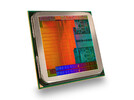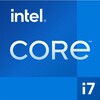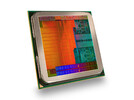AMD A8 Pro-7150B vs Intel Core i7-1260P vs AMD A10-7300
AMD A8 Pro-7150B
► remove from comparison
The AMD A8 Pro-7150B is a power efficient ULV (Ultra Low Voltage) quad-core processor based on the Kaveri architecture. It was revealed in June 2014 for notebooks and is manufactured by GlobalFoundries using a 28 nm SHP process. In addition to having two CPU modules for a total of four integer cores clocked at 1.9 - 3.2 GHz, the AMD chip also integrates a Radeon R5 GPU clocked at up to 533 MHz with 384 GCN shaders and a dual-channel DDR3-1600 memory controller.
Technically, the 7150B is almost identical with the consumer model A10-7300. However, AMD guarantees an especially high stability and durability for the business-oriented Pro-Series.
Architecture
Kaveri is the successor to the 2013 Richland architecture (e.g. A10-5750M). The revised CPU cores, codenamed Steamroller, represent the third generation of the module-based Bulldozer design. A number of major changes include modified decoders (now one per integer core), optimized branch prediction, and increased L1 I-cache from 64 KB to 96 KB per module. These revisions boost the performance per clock slightly over a similarly clocked Richland APU. For more details about the AMD Kaveri architecture, see our detailed analysis here:
Analysis of the AMD Kaveri Notebook Platform
Performance
According to the clock rates, the A8 Pro-7150B should offer a CPU performance level similar to the Haswell-based Intel Core i3-4010U. Overall, the 7150B will be sufficient for all daily workloads (Office, Internet browsing, multimedia) as well as light multitasking. Detailed benchmark can be found on the cpu page of the A10-7300 APU.
Graphics
The Radeon R5 (Kaveri) GPU of the A8 Pro-7150B features a core clock of up to 533 MHz and 384 shader units. Since the GPU is based on AMD's GCN 1.1 architecture, both DirectX 11.2 "Tier 2" and Mantle are supported. Furthermore, the GPU can be used for general purpose computing in various applications, such as Adobe Photoshop via the OpenCL API.
In terms of 3D performance, the GPU should be roughly as fast as a dedicated GeForce GT 720M and can handle many current games at low or medium settings at (W)XGA resolution.
Power Consumption
The power consumption of the entire APU is rated at 19 Watts, which is somewhat above the Haswell ULV CPUs from Intel (15 W including chipset). Nevertheless, the A8 Pro-7150B is suited for 12 - 13-inch notebooks or larger.
Intel Core i7-1260P
► remove from comparison
The Intel Core i7-1260P is an upper mid-range 28 W Alder Lake CPU designed for use in ultra-light laptops. It was announced in early 2022 and it features 4 performance cores as opposed to the 6 cores of the top-of-the-line i7-1280P (P-cores, Golden Cove architecture) mated to 8 efficient cores (E-cores, Gracemont architecture). The P-cores are Hyper-Threading-enabled for a total of 16 threads when combined with the E-cores. The clock speeds range from 2.1 GHz to 4.7 GHz for the performance cluster and 1.5 GHz to 3.4 GHz for the efficient cluster. The i7's shortcomings as compared to Intel Core i7-1270P include the marginally lower clock speeds and limited vPro feature set ("Essentials" tier only, not allowing for remote device management).
Architecture
The i7 is a continuation of Intel's efforts to use the ARM-developed big.LITTLE technology for its own benefit. A single "littile" Alder Lake core is supposed to be just as fast as a Skylake core (as found in the venerable Core i7-6700HQ among other options) which is six years old at this point. All of an Core i7-1260P's CPU cores enjoy access to 18 MB of L3 cache. The integrated memory controller supports various memory types up to LPDDR5-5200, DDR5-4800, LPDDR4x-4267 or DDR4-3200; Intel recommends using no more than 64 GB, for reference. Just like the other 12th Gen Intel Core processors, Intel Core i7-1260P comes with Thread Director which is a new functionality designed to help Windows 11 decide which cores to use for what workload for best performance and efficiency possible. Hardware acceleration of AI algorithms is supported via GNA 3.0 and DL Boost (via AVX2). PCI-Express 5.0 support has not found its way into Alder Lake P processors, so users will have to be content with PCI-Express 4.0 for the time being. Four PCI-Express 4 lanes allow for a read/write rate of up to 7.9 GB/s, provided a suitably fast NVMe SSD is used.
Please note this is not a user-replaceable CPU. It gets soldered permanently on to the motherboard (BGA1744 socket interface).
Performance
Multi-thread performance is most comparable to the Ryzen 7 5800U, Ryzen 7 PRO 5850U and also the Core i5-11260H. This makes the 1260P a great little CPU - one capable of punching above its weight.
Thanks to its decent cooling solution and a long-term CPU power limit of 35 W, the Asus ExpertBook B5 Flip B5602FBN is among the fastest laptops featuring the 1260P that we know of. It can be about 2 times as fast in CPU-bound workloads as the slowest system built around the same chip in our database (as of August 2023).
Graphics
The built-in graphics adapter in the form of the 96 EU Iris Xe running at up to 1.4 GHz has seemingly seen no change from what was built into certain Tiger Lake-UP3 processors, like a i7-1165G7. Which is hardly a downside as this iGPU is loaded with modern features such as AV1 video decoding capability and SUHD 4320p monitor support. Up to 4 monitors can be used simultaneously with this graphics adapter. Its gaming performance is bound to be tied to how high the Power Limits and how good the cooling solution of a laptop are; expect something close to NVIDIA's MX350 or in other words, acceptable framerates in most games when playing at 1080p / Medium settings. Fast RAM is a prerequisite for decent performance as the Iris Xe has to make do with no dedicated video memory. Last but not the least, we discovered that the GPU utilization when playing YouTube UHD 2160p60 videos is higher than it was with Tiger Lake chips.
Power consumption
The i7's base power consumption (also known as the default TDP or Power Limit 1) is 28 W, with 64 W being its maximum Intel-recommended Turbo power consumption (also known as the PL2). Its "Minimum Assured" power consumption sits at 20 W. All in all, an active cooling solution is a must for a CPU like this one here.
The i7-1260P is manufactured on Intel's fourth-gen 10 nm process marketed as Intel 7 for decent, as of late 2022, energy efficiency. Despite that, many 7 nm U-class AMD Ryzen 5000 parts are less power-hungry while being as fast (or even faster, depending on the workload) as the i7.
AMD A10-7300
► remove from comparison
The AMD A10-7300 is a power efficient ULV (Ultra Low Voltage) quad-core processor based on the Kaveri architecture. It was revealed in June 2014 for notebooks and is manufactured by GlobalFoundries using a 28 nm SHP process. In addition to having two CPU modules for a total of four integer cores clocked at 1.9 - 3.2 GHz, the AMD chip also integrates a Radeon R6 GPU clocked at up to 533 MHz with 384 GCN shaders and a dual-channel DDR3-1600 memory controller.
Architecture
Kaveri is the successor to the 2013 Richland architecture (e.g. A10-5750M). The revised CPU cores, codenamed Steamroller, represent the third generation of the module-based Bulldozer design. A number of major changes include modified decoders (now one per integer core), optimized branch prediction, and increased L1 I-cache from 64 KB to 96 KB per module. These revisions boost the performance per clock slightly over a similarly clocked Richland APU. For more details about the AMD Kaveri architecture, see our detailed analysis here:
Analysis of the AMD Kaveri Notebook Platform
Performance
According to our benchmarks, the A10-7300 offers a CPU performance level similar to the Haswell-based Intel Core i3-4010U. Only the single thread performance is a bit lower, despite AMDs significantly higher (turbo) clock rate. Overall, the A10-7300 will be sufficient for all daily workloads (Office, Internet browsing, multimedia) as well as light multitasking.
Graphics
The Radeon R6 (Kaveri) GPU of the A10-7300 features a core clock of up to 533 MHz and 384 shader units. Since the GPU is based on AMD's GCN 1.1 architecture, both DirectX 11.2 "Tier 2" and Mantle are supported. Furthermore, the GPU can be used for general purpose computing in various applications, such as Adobe Photoshop via the OpenCL API.
In terms of 3D performance, the GPU is roughly as fast as a dedicated GeForce GT 720M and can handle many current games (as of 2014) at low or medium settings at (W)XGA resolution.
Power Consumption
The power consumption of the entire APU is rated at 19 Watts, which is somewhat above the Haswell ULV CPUs from Intel (15 W including chipset). Nevertheless, the A10-7300 is suited for 12 - 13-inch notebooks or larger.
| Model | AMD A8 Pro-7150B | Intel Core i7-1260P | AMD A10-7300 | ||||||||||||||||||||||||||||||||||||||||||||||||||||||||||||||||||||||||||||||||||||||||||||||||||||||||
| Codename | Kaveri | Alder Lake-P | Kaveri | ||||||||||||||||||||||||||||||||||||||||||||||||||||||||||||||||||||||||||||||||||||||||||||||||||||||||
| Series | AMD Kaveri | Intel Alder Lake-P | AMD Kaveri | ||||||||||||||||||||||||||||||||||||||||||||||||||||||||||||||||||||||||||||||||||||||||||||||||||||||||
| Series: Kaveri Kaveri |
|
|
| ||||||||||||||||||||||||||||||||||||||||||||||||||||||||||||||||||||||||||||||||||||||||||||||||||||||||
| Clock | 1900 - 3200 MHz | 1500 - 4700 MHz | 1900 - 3200 MHz | ||||||||||||||||||||||||||||||||||||||||||||||||||||||||||||||||||||||||||||||||||||||||||||||||||||||||
| L2 Cache | 4 MB | 10 MB | 4 MB | ||||||||||||||||||||||||||||||||||||||||||||||||||||||||||||||||||||||||||||||||||||||||||||||||||||||||
| Cores / Threads | 4 / 4 | 12 / 16 | 4 / 4 | ||||||||||||||||||||||||||||||||||||||||||||||||||||||||||||||||||||||||||||||||||||||||||||||||||||||||
| TDP | 19 Watt | 28 Watt | 19 Watt | ||||||||||||||||||||||||||||||||||||||||||||||||||||||||||||||||||||||||||||||||||||||||||||||||||||||||
| Transistors | 2410 Million | 2410 Million | |||||||||||||||||||||||||||||||||||||||||||||||||||||||||||||||||||||||||||||||||||||||||||||||||||||||||
| Technology | 28 nm | 10 nm | 28 nm | ||||||||||||||||||||||||||||||||||||||||||||||||||||||||||||||||||||||||||||||||||||||||||||||||||||||||
| Die Size | 245 mm2 | 245 mm2 | |||||||||||||||||||||||||||||||||||||||||||||||||||||||||||||||||||||||||||||||||||||||||||||||||||||||||
| Features | SSE (1, 2, 3, 3S, 4.1, 4.2, 4A), x86-64, AES, AVX, FMA, DDR3-1600 Controller | DDR4-3200/LPDDR4x-4266/DDR5-4800/LPDDR5-5200 RAM, PCIe 4, Thread Director, DL Boost, GNA, MMX, SSE, SSE2, SSE3, SSSE3, SSE4.1, SSE4.2, AVX, AVX2, BMI2, ABM, FMA, ADX, SMEP, SMAP, EIST, TM1, TM2, Hyper-Threading, Turbo, SST, AES-NI, RDRAND, RDSEED, SHA | SSE (1, 2, 3, 3S, 4.1, 4.2, 4A), x86-64, AES, AVX, FMA, DDR3-1600 Controller | ||||||||||||||||||||||||||||||||||||||||||||||||||||||||||||||||||||||||||||||||||||||||||||||||||||||||
| iGPU | AMD Radeon R5 (Kaveri) (? - 533 MHz) | Intel Iris Xe Graphics G7 96EUs ( - 1400 MHz) | AMD Radeon R6 (Kaveri) (? - 533 MHz) | ||||||||||||||||||||||||||||||||||||||||||||||||||||||||||||||||||||||||||||||||||||||||||||||||||||||||
| Architecture | x86 | x86 | x86 | ||||||||||||||||||||||||||||||||||||||||||||||||||||||||||||||||||||||||||||||||||||||||||||||||||||||||
| Announced | |||||||||||||||||||||||||||||||||||||||||||||||||||||||||||||||||||||||||||||||||||||||||||||||||||||||||||
| Manufacturer | www.amd.com | ark.intel.com | www.amd.com | ||||||||||||||||||||||||||||||||||||||||||||||||||||||||||||||||||||||||||||||||||||||||||||||||||||||||
| L1 Cache | 1.1 MB | ||||||||||||||||||||||||||||||||||||||||||||||||||||||||||||||||||||||||||||||||||||||||||||||||||||||||||
| L3 Cache | 18 MB | ||||||||||||||||||||||||||||||||||||||||||||||||||||||||||||||||||||||||||||||||||||||||||||||||||||||||||
| max. Temp. | 100 °C | ||||||||||||||||||||||||||||||||||||||||||||||||||||||||||||||||||||||||||||||||||||||||||||||||||||||||||
| Socket | BGA1744 |
Benchmarks
Average Benchmarks Intel Core i7-1260P → 0% n=0
Average Benchmarks AMD A10-7300 → 0% n=0
* Smaller numbers mean a higher performance
1 This benchmark is not used for the average calculation













